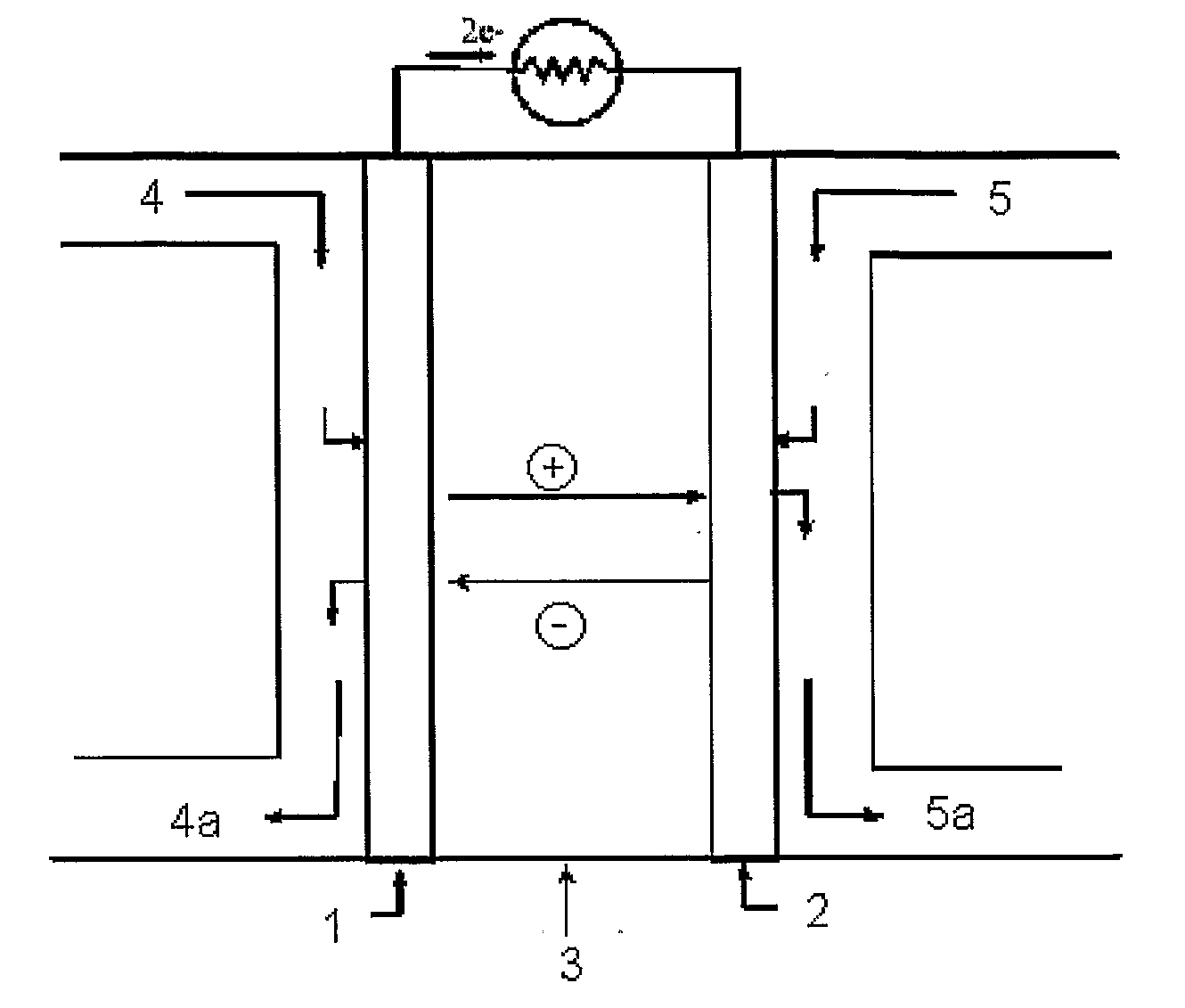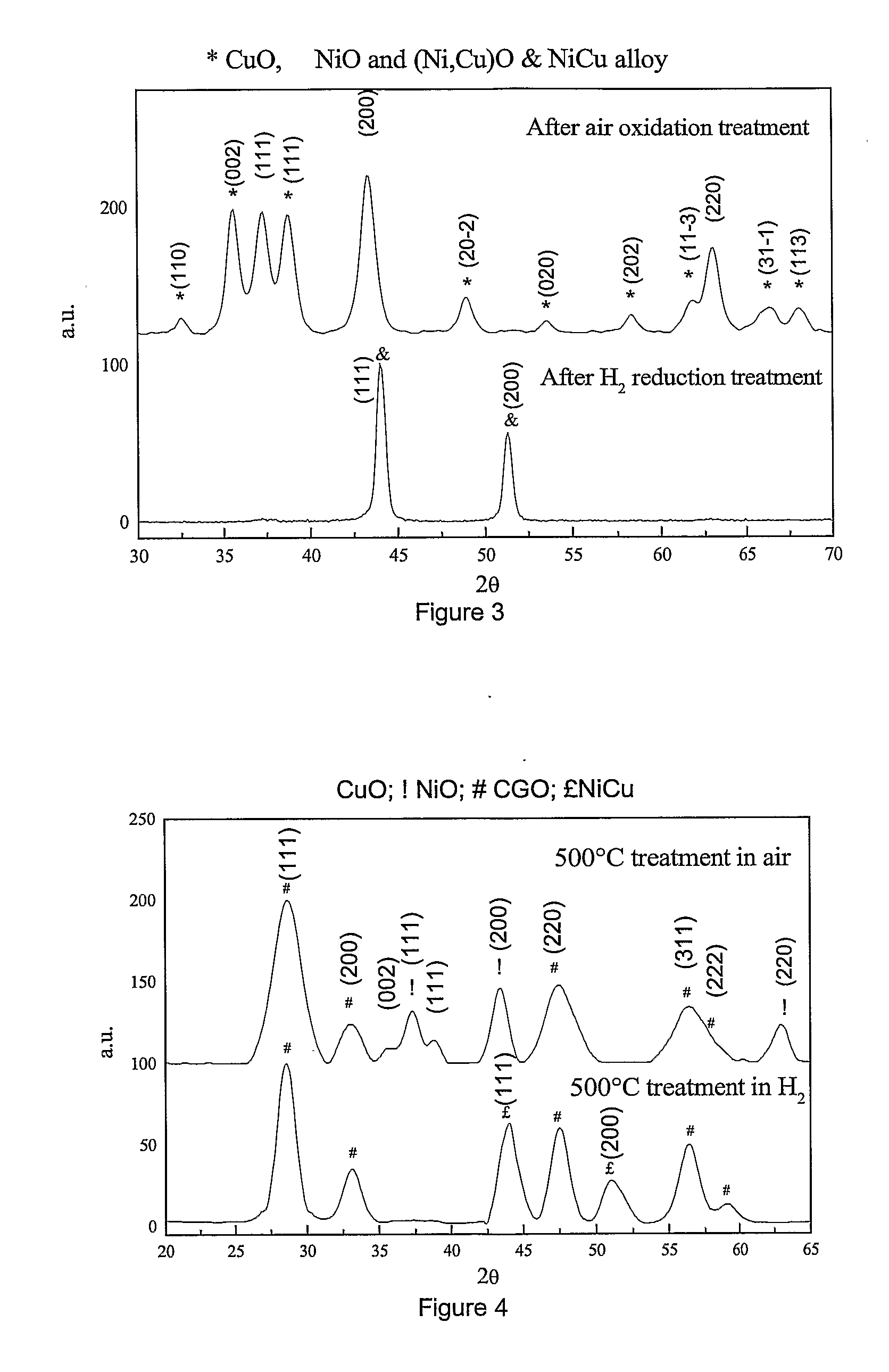Process for Manufacturing an Electrochemical Device
- Summary
- Abstract
- Description
- Claims
- Application Information
AI Technical Summary
Benefits of technology
Problems solved by technology
Method used
Image
Examples
example 1
Cerium / Gadolinium Oxides Nanopowder and Ce0.8Gd0.2O1.9
[0053]1.8716 g of Ce(NO3)3.6H2O and 0.4279 g of Gd(NO3)3.6H2O were added to 10 ml H2O while stirring and heating up to 50° C. to provide a solution with a metal cation concentration of 0.538 mol / l. 10 ml of 2-hydroxyethylmethacrylate and 5 ml polyethyleneglicoldiacrylate were added. The solution was heated up to 100° C. 20 drops of 35 vol % H2O2 were added to initiate the gel formation.
[0054]The resulting gel was decomposed at 500° C. for 5 h. 1 g of the title compound was obtained and characterized as follows.
[0055]The XRD pattern of FIG. 2 shows that the sample is monophasic and Ce0.8Gd0.2O1.9 powder has a mean primary grain size of 10 nm calculated using the Debye-Scherrer formula (A. R. West, “Solid State Chemistry and its application” Ed. John Wiley & Sons, 1996, page 174).
[0056]The nanopowder was compacted in pellet under an uniaxial pressure of 200 MPa and sintered at a temperature of 800° C. for 5 hours, then at 1450° C....
example 2
Copper / Nickel Oxides Nanopowder and Cu0.47Ni0.53 Alloy (1:1 by Weight)
[0058]1 g of Cu was added with 5 ml H2O while stirring and heating up to boiling. HNO3 (3 ml; 65 vol %) was dropwise added, followed by 1 g of Ni. Further HNO3 (3.5 ml; 65 vol %) was added followed by H2O up to a total volume of 10 ml. The resulting solution had a metal cation concentration of 3.277 mol / l. The solution was added with 10 ml of 2-hydroxyethylmethacrylate, 5 ml of polyethyleneglycol diacrylate and 50 mg of AIBN, then heated (80° C.) to yield a gel.
[0059]The gel was dried at 200° C. for 2 h. The resulting xerogel was ground, crashed and decomposed at 500° C. for 2 h to give a mixture of CuO, NiO and Cu0.47Ni0.53O which was characterized as follows.
[0060]FIG. 3 shows the XRD patterns of said mixture. The mean primary grain size was calculated from the XRD patterns by use of the Debye-Scherrer formula (A. R. West “Solid State Chemistry and its application” Ed. John Wiley & Sons, 1996, page 174) giving a...
example 3
Copper / Nickel / Cerium / Gadolinium Oxides Nanopowder and CU0.47Ni0.53 and Ce0.8Gd0.2O1.9 Cermet
[0062]1.164 g of Cu was added with 5 ml of H2O while stirring and heating up to boiling. HNO3 (3.5 ml; 63%) was dropwise added. 1.212 g of Ni was then added followed by HNO3 (63%) up to a total acid volume of 4.3 ml.
[0063]The resulting mixture was added with 5.992 g. of Ce(NO3)3×6H2O, 1.370 g of Gd(NO3)3×6H2O and water up to a total volume of 15 ml to provide a solution with a metal cation concentration of 3.747 mol / l.
[0064]The resulting mixture was added with 15 ml of 2-hydroxyethylmethacrylate, 7.5 ml of polyethyleneglycol diacrylate and 100 mg of AIBN, and heated (80° C.) up to the gel formation.
[0065]The gel was dried at 200° C. for 2 h to yield a xerogel which was ground, crashed and decomposed at 500° C. for 1 h. A powder mixture (6 g) of CuO, NiO, CU0.47Ni0.53O and Ce0.8Gd0.2O1.9 (hereinafter CGO-20) was obtained and characterized as follows.
[0066]FIG. 4 shows the XRD analysis of the p...
PUM
 Login to View More
Login to View More Abstract
Description
Claims
Application Information
 Login to View More
Login to View More - R&D
- Intellectual Property
- Life Sciences
- Materials
- Tech Scout
- Unparalleled Data Quality
- Higher Quality Content
- 60% Fewer Hallucinations
Browse by: Latest US Patents, China's latest patents, Technical Efficacy Thesaurus, Application Domain, Technology Topic, Popular Technical Reports.
© 2025 PatSnap. All rights reserved.Legal|Privacy policy|Modern Slavery Act Transparency Statement|Sitemap|About US| Contact US: help@patsnap.com



